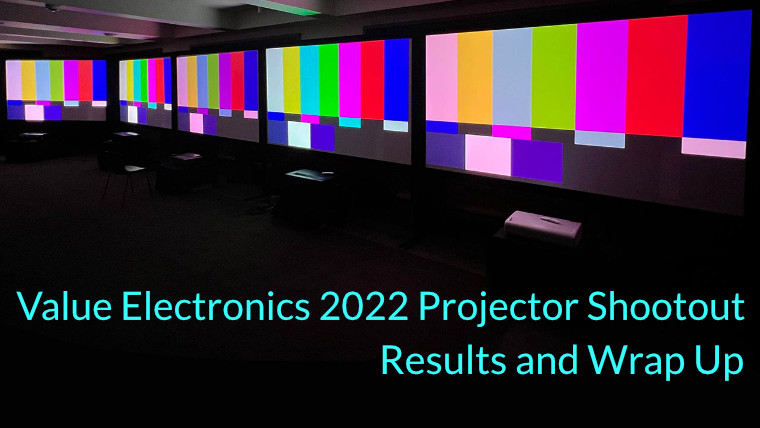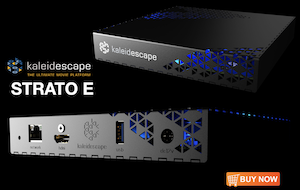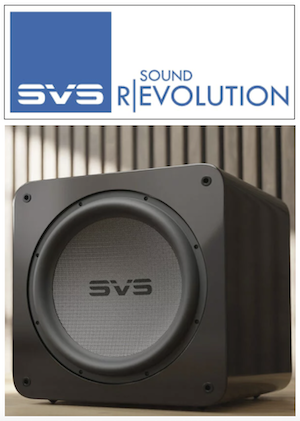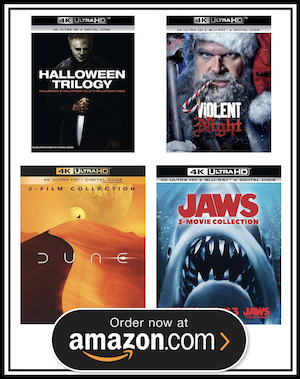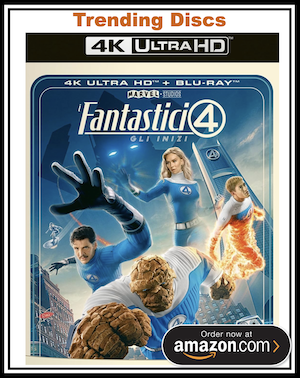(December 11, 2022) All eyes in the AV world were, once again, trained on mid-town Manhattan for another Value Electronics shootout event. This time Robert Zohn and his evaluation team pitted the industry’s best sub-$30,000 long-throw home theater projectors against each other, ultimately crowning three different winners as “King” of their respective price categories.
Much like the Value Electronics Flat Panel Shootout held earlier this year, today’s event occupied ample space at The Company Building on Madison Avenue. The event room allowed four different 120” 16:9 screens to be deployed side-by-side, with any intrusive ambient light properly mitigated by blackout drapes, and screen-reflected light mostly controlled by rigid black-velvet screen dividers. The room, itself, did possess white paint on its ceilings, support columns, and a single rear wall, however, any impact from those surfaces was arguably marginal and universally applied to every projector’s perceived performance during the contest.
The day’s Master of Ceremonies was Phil Jones, co-owner of ProjectorReviews.com and an industry expert with years of experience gained from positions held at Sony and Sound United, and Murideo’s Jason Dustal oversaw set-up and image operations throughout the event. The judging corps, tasked with ranking performance across seven Standard Dynamic Range (SDR) and four High Dynamic Range (HDR) picture categories, consisted of a battery of experts hailing from video and film industries. Filling out the limited attendance gallery was a smattering of press and projector company representatives.
Equipment-wise, the AVProStore and MetraAV provided high-level cabling, distribution equipment, and test equipment – quality was certainly abound. And, all four test screens were identical Seymour-Screen Excellence builds featuring that company’s Radiant White unity gain (1.0) screen material.
The event was divided into three categories or groupings, comprised of projectors priced from $4,000-$7,000 (JVC’s DLA-NP5 at $7,000, Sony’s VPL-XW5000ES at $6,000, LG’s AU810UP at $4,000, and Epson’s LS12000 at $5,000), $11,000 to $16,000 (JVC’s DLA-NZ7 at $11,000 and DLA-NZ8 at $16,000, and Sony’s VPL-XW6000ES at $12,000), and $26,000-$30,000 (JVC DLA-NZ9 at $26,000 and Sony’s VPL-XW7000ES at $28,000). For purposes of this article, we’ll refer to those categories as entry-level, mid-tier, and high-end.
Unlike Value Electronic’s Flat Panel TV Shootout, projectors in this event were not professionally calibrated for optimized performance. Instead, they were pulled from their factory boxes, set to the most accurate preset picture mode, and experts performed minor tweaks to gamma, contrast, and brightness. In other words, these projectors were optimized to a level that consumers might be expected to achieve without hiring a professional calibrator, largely left to operate as each brand sees fit from the factory.
Entry-level contestants featured a range of technologies, including Sony and JVC’s take on true 4K LCoS imaging chips, LG’s DLP technology paired with dual pixel shifting to achieve 4K performance, and Epson’s three LCD chips with dual 4K e-shift. All but the JVC DLA-NP5 possess a laser light source.
Differences in performance were readily apparent, with the JVC DLA-NP5 outperforming its peers in areas of black-level performance, color accuracy, skin tones, motion resolution, and detail/sharpness. The Sony was particularly adept at brightness and 1000 nit tone mapping, while the Epson performed well with SDR tasks and faltered when HDR was introduced. Unfortunately, the lowest-priced competitor, LG’s AU810UP, suffered greatly from an elevated black floor, the rainbow effect, and relatively middling color accuracy and skin tone reproduction.
Entry Level Winner: JVC's DLA-NP5
The mid-tier ($11,000 to $16,000) category pitted Sony versus two JVCs, each relying on laser light sources and three-chip native 4K imaging. JVC’s projectors also possessed two variations of 8K e-shift, with the more expensive NZ8 utilizing a 4-way e-shift technology as opposed to the NZ7’s two-way approach. It’s worth noting that Sony’s entire range of SXDR projectors use the same 4K SXDR processing chip, so the VPL-XW6000ES doesn’t benefit from improvements in that department.
Not surprisingly, results between the Sony and JVC units largely tracked with their less expensive siblings. Again, putting on my own judging hat, The Sony XW6000ES was notably brighter than either JVC, making it a solid choice for rooms with ambient light, and the NZ8 held obvious advantages over the NZ7 in areas of brightness, color accuracy, and near black performance.
The NZ8 was awarded the highest overall aggregate score, with the Sony coming in second and the NZ7 placing third.
Mid-Tier Winner: JVC's DLA-NZ8
Last but not least, the “money is no object” category had JVC’s NZ9 squaring off against Sony’s more expensive XW7000ES. Once again, performance differentiators tracked in line with the companies' less expensive models. Of course, Sony’s XW7000ES gives owners access to even more brightness, and JVC’s NZ9 bumps up its optics with a large lens and higher light output.
The XW7000ES shined when it came to handling bright content, while JVC’s black-level performance was head and shoulders better.
The differences attendees experienced would certainly lessen if each projector were to be properly calibrated and/or hitched with an external image processor. However, calibration would likely reduce overall brightness for the LG and Epson, more so than the JVC and Sony offerings. And, no amount of calibration or image processing can overcome two of Sony’s weak points. The first is Sony’s elevated black floor. When compared side-by-side to a JVC, Sony’s black floor takes on a grey appearance, and when challenged with demanding dark content (such as the infamous Game of Thrones “The Long Night”) episode, Sony’s elevated blacks allow for far fewer shadow details to resolve (see image for a general idea of what I'm referencing, Sony's XW7000ES on left, JVC's NZ9 on right). Black performance gives JVC a massive boost in overall detail and depth.
Second, was the appearance of a chromatic aberration resulting from Sony’s lens on the XW5000ES and XW6000ES. This was notable in the Spears and Munsil test image featuring horses standing in snow, where a very thin green line appeared along the edge of one of the horse’s back. Can you see this aberration when viewing moving content from typical seating distances? Doubtful, but it was still apparent from 5-6 feet from a screen's surface.
Lastly, JVC’s latest firmware update contains factory presets that position its projectors for the best performance when fed various SDR and HDR content. Sony, on the other hand, ships with its projectors with its Reality Creation processing engaged, which imparts levels of sharpness and edge enhancement that negatively impact the overall image. If you're a Sony owner, do yourself a favor and disengage this feature.
Additional Images
Spears and Munsil "Horse" test image
JVC accepts its award
Last edited:







